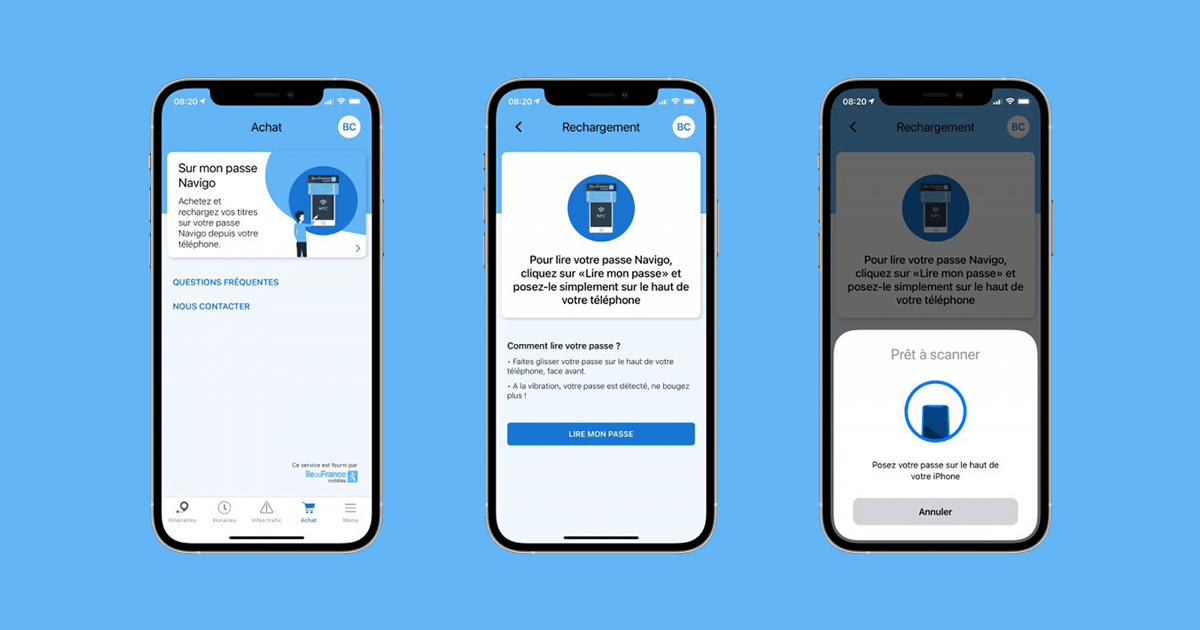The ambition of the Île-de-France application is to offer a genuine “passport to mobility in Ile-de-France”. Replacing the Via Navigo application, created in 2012, it will be renamed Île-de-France Mobilités in January 2021. Developed by Instant System & Sword, the MaaS application offers numerous features.
A “multimodal” experience, allowing the reservation of a single mode of transport among several alternatives. An “intermodal” experience, which aims to offer the best door-to-door journey via the calculator. And finally, a “ticketing” experience, offering direct access to the purchase of transport tickets. Three ways of consuming mobility that we will detail in this article. Without further ado, let’s zoom in on the UX design of this solution MaaS parisian that simplifies travel in France’s largest region. An analysis from our large comparative study.

Multimodal: More than fifteen operators
In a year and a half, IDFM has created its own ecosystem of mobility service providers. From bicycles to public transport and carpooling, users can “prepare, plan and customise their journeys” from among nearly fifteen different transport operators. Six monomodal routes, offering access to planning and booking the following modes of transport:
- Public transport with IDFM and OrlyBus
- Regional trains with Transilien and national trains SNCF
- Bike sharing with Velib, Cristlib, Vélo2 Cergy Pontoise, Véligo (rental)
- Carpooling services with Karos, BlablaLines, Clem, Rezo’pouce, Covoit’ici
- Car-sharing services Communauto and Clem
- Free-floating scooters with Cityscoot
A variety of services were promoted by the launch of a regional multimodal information platform. An open platform facilitating the sharing and exchange of data between different transport operators, private and public companies, etc. A large ecosystem was made possible by a massive investment of no less than 40 million euros, initiated by the Transport Authority. The advantage: total impartiality and openness to competition. A model favored by other MaaS solutions that has a name. Namely, the “open public platform”. One of the four governance models is defined by the UITP (International Association of Public Transport). To discover the other three governance models, please consult our dossier.

An offer available from the homepage (discovery)…
Accessible from the home page, all these offers can be found directly from the interactive map. As a central element of the homepage, the user has access to an overview of the 5 modes of transport available to him. These include buses, trams, trains, self-service bicycles, car-sharing vehicles and free-floating scooters. From a panel at the bottom of the screen, the application also offers the possibility of searching for a route, adding a favourite address, finding recently consulted route searches or network maps. These features are illustrated in the diagram below.

Intermodal: from the first to the last kilometer
When searching for a route, the different results are presented and classified in three tabs, representing different modes of transport. Namely: A first tab including the personal and self-service “Bicycle”. A second one called “IDFM Partners” including carpooling.
And finally, a third tab for “public transport” including buses, trams, metro and suburban trains. There is also an itinerary calculator for planning intermodal journeys. Presented in the form of lists, the user finds the different journey times, departure times, arrival times, the modes of transport to be used, their times of use and traffic information.
Intermodal journeys currently only include public transport and trains (Transilien), for immediate departures or future departures. With the possibility of paying in full (in one go). To find out more about this intermodal experience, please consult our guide.


Ticketing: Reloading the Navigo pass
Thanks to its direct access to the Navigo distribution system operated by IDFM Paris, the MaaS appli offers its users a completely digital ticketing system. In addition to being able to buy dematerialized tickets, it also allows users to recharge their Navigo pass (smart card). This is a particularly rare ticketing experience because it combines a physical experience with a digital one. “There is no longer any need to queue to load your pass: whether you want to top up your monthly pass or make a one-off journey. And this is done by simply placing your pass on the back of your smartphone.
Compatibility between different terminals and media is made possible by NFC technology compatible for Android smartphones and iPhones from iPhone 7 onwards with at least iOS 13 version, and at least iOS 14.5 version for iPhones XR, XS and XS Max.
Once in the station, the user only has to validate their ticket, from the different Navigo passes (Day, Week and Month) to the t+ ticket books… With the possibility of paying with Apple Pay and validating directly with their smartphone. A validation method, known as “pre-purchase”, based on three basic cEMV models defined by the UK Card Association, namely :

Single tap
In this first model, the user validates his support (card or smartphone) at the beginning of each new trip. No fare calculation. He will be automatically debited with a fixed amount, known in advance.

Double tap
This second model offers more flexibility in terms of pricing. Indeed, the user is billed precisely for the trip made thanks to the double-tap system at the entrance and exit of the transport network.

Pre-purchase
In the latter model, the user must purchase a ticket before the trip. A model that offers a wider view of the public transport or train offer.
Unique access that does not stop there, with the launch a few months ago of Île-de-France Mobilités Connect. A unique database to simplify the journey of internet users on the IDF Mobilités app. To find out more, please see our article dedicated to this innovation, which could be extended to various other MaaS applications.
Overview of the IDFM’s user experience

To discover the different UX approaches, don’t hesitate to consult
our complete benchmark of the 10 MaaS applications.






